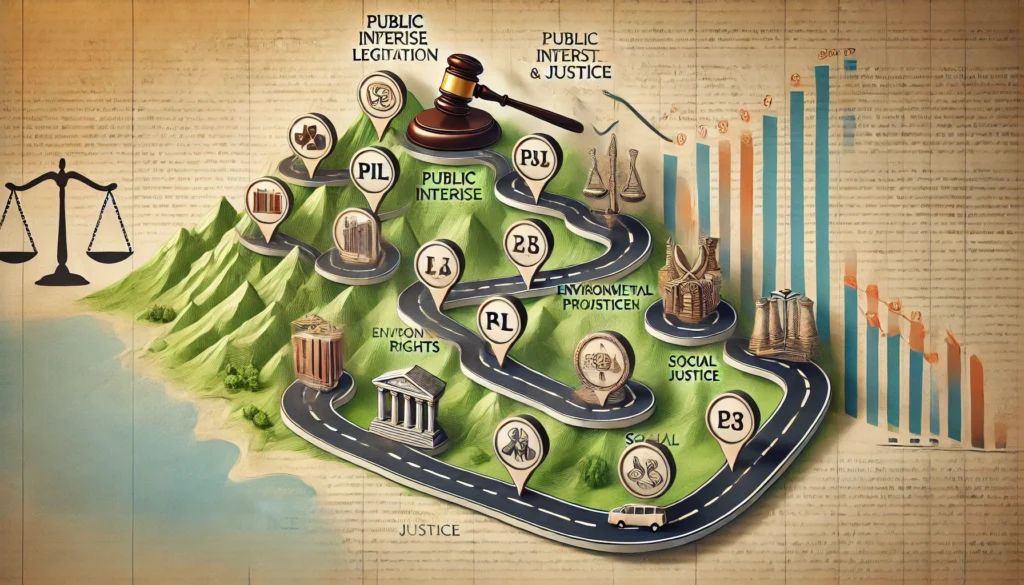
This article has been written by Ananya Shruti, First-year BBA. LL.B student, Symbiosis Law School, Hyderabad.

ABSTRACT –
The evolution of Public Interest Litigation (PIL) in India marks a momentous shift in the judicial landscape of the country, redefining the role of the judiciary as protector of public rights and a catalyst for social justice. Emerging in the late 20th century, PIL was a dynamic instrument of judicial activism that enabled the courts, particularly the Supreme Court and High Courts, to transcend the traditional boundaries of litigation. Through the writ jurisdiction, PILs have democratized access to justice, allowing marginalized groups, public-spirited individuals, and civil society organizations to seek legal remedies on issues affecting the collective welfare of society. This article goes into the historical evolution of PILs, tracing the roots of their conceptualization in the 1970s to modern-day significance. The chronological discussion of landmark cases helps it analyse how judicial pronouncements have shaped the trajectory of PILs and expanded the scope of fundamental rights under the Indian Constitution.
Some examples of these cases include Hussainara Khatoon v. State of Bihar, and MC Mehta v. Union of India, which transformed the Indian judicial system through PILs that brought to attention issues related to environmental degradation, violation of human rights, governmental accountability, and social justice.
This article goes further in discussing how PILs have evolved to become a tool for legal innovation that helps courts apply justice, equity, and good governance principles. In so doing, the gap between law and society continues to be bridged by PILs, and the judiciary continues to reaffirm its commitment to the public interest as well as making the legal system more inclusive.
The analysis highlights both the advantages and disadvantages associated with the PIL mechanism, underscoring its pivotal role in advancing the cause of justice in India’s constitutional democracy.
KEYWORDS – Public Interest Litigation, Article, Locus Standi, Writ jurisdiction, Court
INTRODUCTION –
Public Interest Litigation (PIL) is a legal mechanism that allows individuals, organizations, or groups to approach the judiciary to seek redress for issues concerning public interest, particularly where the rights of marginalized or underprivileged sections of society are violated. It enables the courts to intervene in matters affecting the collective welfare of society, ensuring the enforcement of fundamental rights and legal protections under the Constitution of India. Unlike traditional litigation, PIL does not require direct personal injury to the petitioner and can be filed on behalf of those unable to access justice themselves, thereby democratizing access to the judicial system.
Even though Public Interest Litigation (PIL) is not defined in any statute or act, it is interpreted by the judges to consider the intend of the public at large.
ADVANTAGES OF PIL –
Advantages of Public Interest Litigation are:
- Vigilant citizens can find an inexpensive remedy because there is only a nominal rate of court fees.
- Litigants can focus attention on an achieve results pertaining to larger public issues especially in the field of human rights, consumer welfare and the environment.
DISADVANTAGES OF PIL –
Disadvantages of Public Interest Litigation are:
- Many people started handling PIL as a tool for harassment because frivolous cases can be filed without heavy court fee as compared to private litigations.
- Due to the flexibility of character of the PIL, the opposite party gets an opportunity to ascertain the precise allegation and respond to specific issues.
- The judiciary has been criticised due to the overstepping of its jurisdiction and that it is unable to implement its orders effectively.
- PIL is being misused by the public agitating for private grievances in the grab of public interest by seeking publicity rather than supporting the public cause.
The definition regarding the term ‘Public Interest Litigation’ is that it is the litigation for the public interest. In India, Article 32 of the Indian Constitution contains provisions regarding the involvement of public in the judiciary. A PIL may be introduced in the court suo moto, rather than the aggrieved party or any other third party. In such a suit, the right to file the suit is given to the member or by the Court through judicial activism. The member of the public may be a non-governmental organisation (NGO), an institution or an individual.
HISTORY OF PIL –
The concept of Public Interest Litigation (PIL) originated in the United States (US), mainly to provide legal assistance to disadvantaged groups.
In India, PILs gained prominence in the late 1970s and early 1980s, spearheaded by activist judges who sought to make justice accessible to marginalised sections of society. This marked a shift from the traditional adversarial system of litigation, which often restricted access to courts to only those with a direct personal interest in a case.
WHO CAN FILE A PUBLIC INTEREST LITIGATION (PIL)?
Any individual can file a PIL either in his/her/their own standing that is to protect or enforce a right owed to him/her/them by the government or on behalf of a section of society who is disadvantaged or oppressed and is not able to enforce their own rights.
The concept of Locus Standi has been relaxed in the case of PILs so as to enable the Hon’ble High Court to look into grievances that are filed on behalf of those who are poor, illiterate, deprived or disabled and are unable to approach the courts themselves.
However, only a person acting in good faith and who has sufficient interest in the proceeding will have the locus standi to file a PIL. A person who approaches the Hon’ble Court for personal gain, private profit, political or any oblique consideration will not be entertained.
Suo moto cognizance may also be taken by the court.
WHERE CAN A PIL BE FILED?
PILs are extensions of Writ Jurisdiction. Therefore, PILs may be filed either before the Hon’ble High Court of India under Article 32[1] of the Indian Constitution or any High Court under Article 226[2] of the Indian Constitution.
LAWS GOVERNING PIL IN INDIA –
- Relaxed rule of Locus Standi: PILs can be filed by any person for the welfare of others who are disadvantaged and are thus unable to approach the courts themselves. Thus, the general rule of locus standi has been relaxed in cases of PILs to protect and safeguard the interests and rights of these disadvantaged people.
- Locus Standi is a Latin term that means “the right to stand” or the right to bring an action” in a court of law. In other words, it refers to a person’s legal capacity or entitlement to spear before a court and seek relief.
- In simpler terms, for a person or entity to file a lawsuit or petition, they must demonstrate that they have a direct and substantial interest in the matter. Without Locus standi, the court may dismiss the case on procedural grounds, regardless of its merits.
- In legal contexts:
- Personal interest: The claimant must show that they are directly affected by the issue they are bringing to the court.
- Public Interest Litigation (PIL): In some jurisdictions, particularly in cases involving broader societal concerns, courts may relax locus standi rules to allow individuals or organizations without direct personal harm to bring a case on behalf of the public.
- Relaxed procedural rules: Courts have treated even a letter or a telegram as a PIL. Even the law regarding pleadings have been relaxed by the courts in cases of PILs.
- Intervention by the courts: Courts has also highlighted the fact that Article 14 and 21 of the constitution of India and the International conventions on Human Rights provide for a fair and reasonable trial. Thus, courts must intervene when injustice is done.
- Question of Maintainability: The government may not be allowed to raise questions as to the maintainability of the PIL if the court is prime facie satisfied that there is a variation of any constitutional rights of a disadvantaged category of people.
- Principle of Res Judicata: The principle of Res-Judicata or any principles analogous, it depends on the circumstances, facts and nature of the PIL.
- Appointment of a commission: In special circumstances, a court may appoint a commission or other bodies to investigate. In the event that the commission takes over a public institution, court may direct management to it.
- Complete Justice: Under Article 142[3] of the constitution of India, the Hon’ble Supreme Court of India has the discretionary power to pass a decree or order as may be necessary to do complete justice. However, while High Courts may pass orders to do complete justice, they do not have powers akin to those granted to the Hon’ble Supreme Court under Article 142.
- Misuse of PILs: Courts are extremely cautious ensuring that PILs are not misused as this would defeat the very purpose for which it was made. However, courts have held that even if the petitioner had approached the court for his personal interest due to own grievances, the court may treat it necessary to inquire into the subject of the litigation and its state of affairs in furtherance to public interest.
- Formulation of various concepts: The courts have formulated and evolved several concepts including the polluter pays principle, the precautionary principle, the public trust doctrine, and sustainable development.
LANDMARK CASES –
The beginning of PILs:
- Hussainara Khatoon vs. State of Bihar (1979)[4]
This case marked the advent of PILs in India.
Facts:
- Advocate Pushpa Hingorani, the mother of Public Interest Litigation (PIL), filed a habeas Corpus writ before the court, highlighting the instances of injustice against prisoners in Patna and Muzaffarpur jails.
- In this, she highlighted the denial of the right of prisoners to a speedy trial and the issue of prolonged detention without the grant of bail, even after the expiration of their detention period.
- A report was made in the National Police Commission in Bihar in 1977, which was later printed in the Indian Express newspaper.
- On his visit to Muzaffarpur and Patna jails, it was caught to his notice that
- there were many trial prisoners in jail, even after the expiration period of their detention period.
- But due to lack of enough legal knowledge, they weren’t aware of the court procedure.
- After having read the article, Advocate Puspa presented a writ petition before the Supreme Court of India on behalf of Hussaini Khatoon and all others at jail.
Issues raised:
- Whether the right to speedy trial is encompassed under Article 21.
- Whether free legal aid should be interpreted as part of the directive principle of state policy.
Judgements:
- The judgement was pronounced in the favour of the petitioner as the respondent, despite the notice period, had not appeared in the court.
- The court held that all those whose names were mentioned in her writ should be bailed immediately.
- Immediate bail was granted to all of them.
- The court further ordered the High Court and the State government to make a list of all the pending cases and submit to the court by December 31, 1978.
- The court highlighted the irresponsible behaviour of our judicial system that discriminated between rich and poor and failed to ensure that every prisoner can exercise their fundamental rights under Article 21 of the Indian Constitution.
- P. Gupta vs. Union of India (1981)[5]
This case is also known as the “Judges’ transfer case” and expanded the concept of Locus Standi.
Facts:
- In 1981, a lot of writ petitions were filed in different High Court, the issue of all being the same.
- All the petitions filed challenged an order of the government on the no-appointment of 2 judges and their transfer.
- The first petition was filed in the Bombay High Court followed by the second one in Delhi High Court, not only challenging the central government but also the constitutional validity of the procedural followed for the appointment of the judges.
- One petition was filed by S.P. Gupta, who served as an attorney in the Allahabad High Court during that time.
Issues:
- Constitutional validity of the procedures.
- Locus standi of the petitioners, challenged.
Judgements:
- The majority decision held the non-extension of an additional judge
Expansion and recognition of PILs in India:
- Bandhua Mukti Morcha vs. Union of India (1984)[6]
This case highlighted the working conditions of the bonded labour.
Facts:
- The petitioner Bandhua Mukti Morcha is an NGO which works for the welfare of the people.
- While they were conducting a survey, they found some stone quarries in Faridabad where the workmen were in extreme situations.
- The working conditions there were very unhygienic and unsuitable for these workers who had come from different parts of the country to work here.
- The petitioner wrote a letter to Justice Bhagwati regarding the workplace and working conditions of those workmen.
- This letter was taken as a writ petition under Article 32 of the constitution and a commission was made to enquire about the allegations put forth by the petitioner.
Issues:
- Whether the writ petition filed under Article 32 of the constitution is valid or not.
- Whether any fundamental right of the worker was actually violated or not.
- Whether the Supreme court is empowered to appoint any commission or investigating body under Article 32 of the constitution or not.
- Whether the workmen mentioned tin the case are bonded labourers are not.
- Whether workmen in the present case entitled to relief under various social labour legislations or not.
Judgements:
- The Supreme Court found the petition true and therefore gave directions to the government of Haryana, the Central Government and other administrative authorities as follows:
- The government of Haryana within 6 weeks of the judgement shall constitute a vigilance committee in each division of district to ensure compliance under Section 13 of the Bonded Labour Act, 1976.
- The government of Haryana will appoint a district magistrate to identify the bonded labour as per the law/
- The state government also has to take the help of NGO’s and other voluntary agencies to ensure the implementation of the Bonded Labour Act, 1976
- The government of Haryana, within 3 month of the judgement has to re-habitat the bonded labourers.
- Both the Central and State Government together must ensure the implementation of the Minimum Wages Act, 1948.
- The concern offices from the Central government has to conduct surprise visits at least once a week.
- The Central Board of Workers education will organise camps often to educate the workers about their rights and benefits provided by law.
- C. Mehta vs. Union of India (1986)[7]
This case is also known as the Oleum Gas leak.
Facts:
- On December 4th 1985, an incident of a major leakage of oleum gas happened from one of the units of Shriram.
- The leakage physically affected many common public – both the workmen as well as common people outside.
- Moreover, an advocate practising in the Tis Hazari Court died after inhaling Oleum Gas.
- The incident was confirmed by both the petitioner and the Delhi Bar Association.
Issues:
- Whether the Supreme court had the authority under Article 32 to decide Shriram to restart its caustic chlorine plant?
- What are the necessary conditions to be satisfied in order to run an industrial unit in a heavy populated area.
Judgements:
- Keeping in mind the concerns of the safety of people, the judge stated the proposal to eliminate toxic and hazardous factories could not be followed because they contribute to improving the quality of life.
- Industries must be established.
- The court ordered that the factory be opened temporarily under 11 conditions and appointed a committee of experts to control the activity of the industry.
CONCLUSION –
The history of Public Interest Litigation in India testifies to the dynamic and progressive nature of its judiciary. Since its inception in the late 1970s, PILs have blossomed into a powerful tool for delivering social justice, safeguarding fundamental rights, and redressing failures of governance and administration. By relaxing the traditional *locus standi* rules, the judiciary has ensured that the voiceless and marginalized find representation and justice within the legal framework. Landmark cases such as Hussainara Khatoon, Bandhua Mukti Morcha, and M.C. Mehta reflect how PILs have shaped India’s legal landscape and expanded the scope of constitutional rights. However, the history of PILs has not been without hurdles. Matters of judicial overreach, frivolous petitions, and misuse of PILs for personal or political motives raise questions about the credibility and efficacy of PILs. On the other hand, despite the vigilance with which courts have protected the public interest, a judicious approach is necessary in order to avoid diluting this rich legal tool.
In essence, PILs symbolize the commitment of the judiciary towards justice, equality, and the rule of law. As they continue to evolve, it is imperative to safeguard their integrity and ensure that they remain a medium for genuine public good, fostering a more just, equitable, and accountable society.
[1] Indian Constitution, Art. 32
[2] Notwithstanding anything in Article 32 every High Court shall have powers, throughout the territories in relation to which it exercise jurisdiction, to issue to any person or authority, including in appropriate cases, any Government, within those territories directions, orders or writs, including writs in the nature of habeas corpus, mandamus, prohibitions, quo warranto and certiorari, or any of them, for the enforcement of any of the rights conferred by Part III and for any other purpose
[3] The decree or order passed by the supreme court is enforceable throughout the territory on India.
[4] Hussainara Khatoon vs. State of Bihar 1979 AIR1369, 1979 SCR (3) 532
[5] S.P. Gupta vs. Union of India (1981) AIR 1982 SC 149
[6] Bandhua Mukti Morcha vs. Union of India (1984)
[7] M.C. Mehta vs. Union of India 1986 AIR 965, 1986 SCR (1) 312






